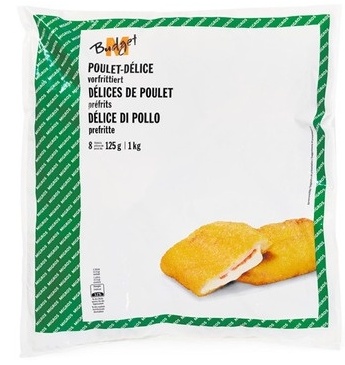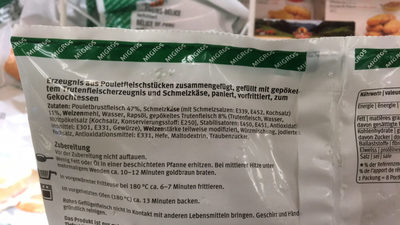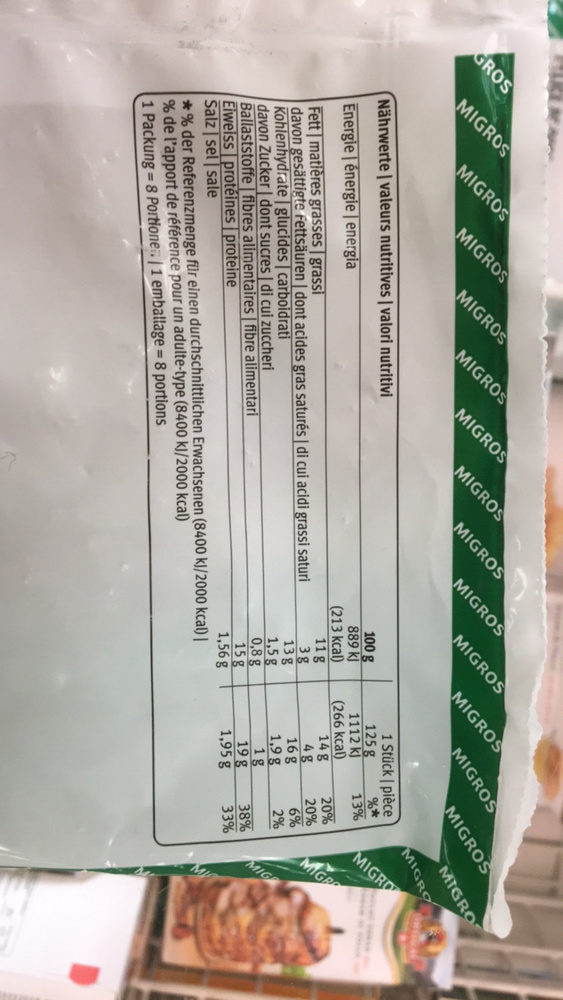Help us make food transparency the norm!
As a non-profit organization, we depend on your donations to continue informing consumers around the world about what they eat.
The food revolution starts with you!
Délices de poulet - M-Budget - 1000 g
Délices de poulet - M-Budget - 1000 g
This product page is not complete. You can help to complete it by editing it and adding more data from the photos we have, or by taking more photos using the app for Android or iPhone/iPad. Thank you!
×
Barcode: 7610200383266 (EAN / EAN-13)
Quantity: 1000 g
Categories: Meats and their products, Meals, Meat preparations, Meats, Chicken and its products, Poultries, Breaded products, Chickens, Cordons bleus
Manufacturing or processing places: Suisse
Stores: Migros
Countries where sold: Switzerland
Matching with your preferences
Health
Ingredients
-
31 ingredients
French: Viande de poitrine de poulet 47 %, fromage fondu (avec sels de fonte: E339, E452, sel de cuisine ) 11%, farine de blé, eau, huile de colza, viande de dinde saumurée 8 % [viande de dinde, eau, sel nitrité pour saumure (sel de cuisine, conservateur: E250), stabilisants: E450, E451, antioxydants: E301, E331, épices], amidon de blé partiellement modifié, mélange de condiments, sel de cuisine iodé, antioxydant: E 331, levure, maltodextrine, glucose.Allergens: Gluten, Milk
Food processing
-
Ultra processed foods
Elements that indicate the product is in the 4 - Ultra processed food and drink products group:
- Additive: E450 - Diphosphates
- Additive: E451 - Triphosphates
- Additive: E452 - Polyphosphates
- Ingredient: Glucose
- Ingredient: Maltodextrin
Food products are classified into 4 groups according to their degree of processing:
- Unprocessed or minimally processed foods
- Processed culinary ingredients
- Processed foods
- Ultra processed foods
The determination of the group is based on the category of the product and on the ingredients it contains.
Additives
-
E250 - Sodium nitrite
Sodium nitrite: Sodium nitrite is the inorganic compound with the chemical formula NaNO2. It is a white to slightly yellowish crystalline powder that is very soluble in water and is hygroscopic. It is a useful precursor to a variety of organic compounds, such as pharmaceuticals, dyes, and pesticides, but it is probably best known as a food additive to prevent botulism. It is on the World Health Organization's List of Essential Medicines, the most important medications needed in a basic health system.Nitrate or nitrite -ingested- under conditions that result in endogenous nitrosation has been classified as "probably carcinogenic to humans" by International Agency for Research on Cancer -IARC-.Source: Wikipedia
-
E301 - Sodium ascorbate
Sodium ascorbate: Sodium ascorbate is one of a number of mineral salts of ascorbic acid -vitamin C-. The molecular formula of this chemical compound is C6H7NaO6. As the sodium salt of ascorbic acid, it is known as a mineral ascorbate. It has not been demonstrated to be more bioavailable than any other form of vitamin C supplement.Sodium ascorbate normally provides 131 mg of sodium per 1‚000 mg of ascorbic acid -1‚000 mg of sodium ascorbate contains 889 mg of ascorbic acid and 111 mg of sodium-. As a food additive, it has the E number E301 and is used as an antioxidant and an acidity regulator. It is approved for use as a food additive in the EU, USA, and Australia and New Zealand.In in vitro studies, sodium ascorbate has been found to produce cytotoxic effects in various malignant cell lines, which include melanoma cells that are particularly susceptible.Source: Wikipedia
-
E331 - Sodium citrates
Sodium citrate: Sodium citrate may refer to any of the sodium salts of citrate -though most commonly the third-: Monosodium citrate Disodium citrate Trisodium citrateThe three forms of the salt are collectively known by the E number E331. Sodium citrates are used as acidity regulators in food and drinks, and also as emulsifiers for oils. They enable cheeses to melt without becoming greasy.Source: Wikipedia
-
E339 - Sodium phosphates
Sodium phosphates: Sodium phosphate is a generic term for a variety of salts of sodium -Na+- and phosphate -PO43−-. Phosphate also forms families or condensed anions including di-, tri-, tetra-, and polyphosphates. Most of these salts are known in both anhydrous -water-free- and hydrated forms. The hydrates are more common than the anhydrous forms.Source: Wikipedia
-
E450 - Diphosphates
Diphosphates (E450) are food additives often utilized to modify the texture of products, acting as leavening agents in baking and preventing the coagulation of canned food.
These salts can stabilize whipped cream and are also found in powdered products to maintain their flow properties. They are commonly present in baked goods, processed meats, and soft drinks.
Derived from phosphoric acid, they're part of our daily phosphate intake, which often surpasses recommended levels due to the prevalence of phosphates in processed foods and drinks.
Excessive phosphate consumption is linked to health issues, such as impaired kidney function and weakened bone health. Though diphosphates are generally regarded as safe when consumed within established acceptable daily intakes, it's imperative to monitor overall phosphate consumption to maintain optimal health.
-
E451 - Triphosphates
Sodium triphosphate: Sodium triphosphate -STP-, also sodium tripolyphosphate -STPP-, or tripolyphosphate -TPP-,- is an inorganic compound with formula Na5P3O10. It is the sodium salt of the polyphosphate penta-anion, which is the conjugate base of triphosphoric acid. It is produced on a large scale as a component of many domestic and industrial products, especially detergents. Environmental problems associated with eutrophication are attributed to its widespread use.Source: Wikipedia
Ingredients analysis
-
Palm oil free
No ingredients containing palm oil detected
-
Non-vegan
Non-vegan ingredients: fr:Viande de poitrine de poulet, Melted cheese, Turkey meat, Turkey meat
-
Non-vegetarian
Non-vegetarian ingredients: fr:Viande de poitrine de poulet, Turkey meat, Turkey meat
-
Details of the analysis of the ingredients
fr: Viande de poitrine de poulet 47%, fromage fondu 11% (avec sels de fonte (e339), e452, sel de cuisine), farine de blé, eau, huile de colza, viande de dinde 8% (viande de dinde, eau, sel nitrité pour saumure (sel de cuisine, conservateur (e250)), stabilisants (e450), e451, antioxydants (e301), e331, épices), amidon de blé partiellement modifié, mélange de condiments, sel de cuisine iodé, antioxydant (e331), levure, maltodextrine, glucose- Viande de poitrine de poulet -> fr:viande-de-poitrine-de-poulet - vegan: no - vegetarian: no - ciqual_food_code: 36005 - percent_min: 47 - percent: 47 - percent_max: 47
- fromage fondu -> en:melted-cheese - vegan: no - vegetarian: maybe - ciqual_proxy_food_code: 12999 - percent_min: 11 - percent: 11 - percent_max: 11
- avec sels de fonte -> en:emulsifying-salts - percent_min: 3.94 - percent_max: 11
- e339 -> en:e339 - vegan: yes - vegetarian: yes - percent_min: 3.94 - percent_max: 11
- e452 -> en:e452 - vegan: yes - vegetarian: yes - percent_min: 0 - percent_max: 5.5
- sel de cuisine -> en:salt - vegan: yes - vegetarian: yes - ciqual_food_code: 11058 - percent_min: 0 - percent_max: 1.56
- avec sels de fonte -> en:emulsifying-salts - percent_min: 3.94 - percent_max: 11
- farine de blé -> en:wheat-flour - vegan: yes - vegetarian: yes - ciqual_proxy_food_code: 9410 - percent_min: 8 - percent_max: 11
- eau -> en:water - vegan: yes - vegetarian: yes - ciqual_food_code: 18066 - percent_min: 8 - percent_max: 11
- huile de colza -> en:colza-oil - vegan: yes - vegetarian: yes - from_palm_oil: no - ciqual_food_code: 17130 - percent_min: 8 - percent_max: 11
- viande de dinde -> en:turkey-meat - vegan: no - vegetarian: no - ciqual_food_code: 36301 - percent_min: 8 - percent: 8 - percent_max: 6.5
- viande de dinde -> en:turkey-meat - vegan: no - vegetarian: no - ciqual_food_code: 36301 - percent_min: 1 - percent_max: 6.28571428571429
- eau -> en:water - vegan: yes - vegetarian: yes - ciqual_food_code: 18066 - percent_min: 0.214285714285714 - percent_max: 3.25
- sel nitrité pour saumure -> en:e250 - vegan: yes - vegetarian: yes - percent_min: 0 - percent_max: 2.16666666666667
- sel de cuisine -> en:salt - vegan: yes - vegetarian: yes - ciqual_food_code: 11058 - percent_min: 0 - percent_max: 1.56
- conservateur -> en:preservative - percent_min: 0 - percent_max: 1.08333333333333
- e250 -> en:e250 - vegan: yes - vegetarian: yes - percent_min: 0 - percent_max: 1.08333333333333
- stabilisants -> en:stabiliser - percent_min: 0 - percent_max: 1.625
- e450 -> en:e450 - vegan: yes - vegetarian: yes - percent_min: 0 - percent_max: 1.625
- e451 -> en:e451 - vegan: yes - vegetarian: yes - percent_min: 0 - percent_max: 1.3
- antioxydants -> en:antioxidant - percent_min: 0 - percent_max: 1.08333333333333
- e301 -> en:e301 - vegan: yes - vegetarian: yes - percent_min: 0 - percent_max: 1.08333333333333
- e331 -> en:e331 - vegan: yes - vegetarian: yes - percent_min: 0 - percent_max: 0.928571428571429
- épices -> en:spice - vegan: yes - vegetarian: yes - percent_min: 0 - percent_max: 0.880952380952381
- amidon de blé partiellement modifié -> en:partially-modified-wheat-starch - vegan: yes - vegetarian: yes - ciqual_proxy_food_code: 9510 - percent_min: 0.357142857142857 - percent_max: 3.6
- mélange de condiments -> en:mixed-condiments - vegan: maybe - vegetarian: maybe - percent_min: 0 - percent_max: 2.94047619047619
- sel de cuisine iodé -> en:iodised-salt - vegan: yes - vegetarian: yes - ciqual_food_code: 11058 - percent_min: 0 - percent_max: 1.56
- antioxydant -> en:antioxidant - percent_min: 0 - percent_max: 1.56
- e331 -> en:e331 - vegan: yes - vegetarian: yes - percent_min: 0 - percent_max: 1.56
- levure -> en:yeast - vegan: yes - vegetarian: yes - percent_min: 0 - percent_max: 1.56
- maltodextrine -> en:maltodextrin - vegan: yes - vegetarian: yes - percent_min: 0 - percent_max: 1.56
- glucose -> en:glucose - vegan: yes - vegetarian: yes - ciqual_proxy_food_code: 31016 - percent_min: 0 - percent_max: 1.56
Nutrition
-
Average nutritional quality
⚠ ️Warning: the amount of fruits, vegetables and nuts is not specified on the label, it was estimated from the list of ingredients: 9This product is not considered a beverage for the calculation of the Nutri-Score.
Positive points: 5
- Proteins: 5 / 5 (value: 15, rounded value: 15)
- Fiber: 0 / 5 (value: 0.8, rounded value: 0.8)
- Fruits, vegetables, nuts, and colza/walnut/olive oils: 0 / 5 (value: 9.5, rounded value: 9.5)
Negative points: 10
- Energy: 2 / 10 (value: 889, rounded value: 889)
- Sugars: 0 / 10 (value: 1.5, rounded value: 1.5)
- Saturated fat: 2 / 10 (value: 3, rounded value: 3)
- Sodium: 6 / 10 (value: 624, rounded value: 624)
The points for proteins are counted because the negative points are less than 11.
Nutritional score: (10 - 5)
Nutri-Score:
-
Nutrient levels
-
Fat in moderate quantity (11%)
What you need to know- A high consumption of fat, especially saturated fats, can raise cholesterol, which increases the risk of heart diseases.
Recommendation: Limit the consumption of fat and saturated fat- Choose products with lower fat and saturated fat content.
-
Saturated fat in moderate quantity (3%)
What you need to know- A high consumption of fat, especially saturated fats, can raise cholesterol, which increases the risk of heart diseases.
Recommendation: Limit the consumption of fat and saturated fat- Choose products with lower fat and saturated fat content.
-
Sugars in low quantity (1.5%)
What you need to know- A high consumption of sugar can cause weight gain and tooth decay. It also augments the risk of type 2 diabetes and cardio-vascular diseases.
Recommendation: Limit the consumption of sugar and sugary drinks- Sugary drinks (such as sodas, fruit beverages, and fruit juices and nectars) should be limited as much as possible (no more than 1 glass a day).
- Choose products with lower sugar content and reduce the consumption of products with added sugars.
-
Salt in high quantity (1.56%)
What you need to know- A high consumption of salt (or sodium) can cause raised blood pressure, which can increase the risk of heart disease and stroke.
- Many people who have high blood pressure do not know it, as there are often no symptoms.
- Most people consume too much salt (on average 9 to 12 grams per day), around twice the recommended maximum level of intake.
Recommendation: Limit the consumption of salt and salted food- Reduce the quantity of salt used when cooking, and don't salt again at the table.
- Limit the consumption of salty snacks and choose products with lower salt content.
-
-
Nutrition facts
Nutrition facts As sold
for 100 g / 100 mlAs sold
per serving (125 g)Compared to: Cordons bleus Energy 889 kj
(212 kcal)1,110 kj
(265 kcal)-2% Fat 11 g 13.8 g -6% Saturated fat 3 g 3.75 g -3% Carbohydrates 13 g 16.2 g -4% Sugars 1.5 g 1.88 g +9% Fiber 0.8 g 1 g -47% Proteins 15 g 18.8 g +9% Salt 1.56 g 1.95 g +19% Alcohol 0 % vol 0 % vol Fruits‚ vegetables‚ nuts and rapeseed‚ walnut and olive oils (estimate from ingredients list analysis) 9.5 % 9.5 %
Environment
-
Eco-Score E - Very high environmental impact
⚠ ️Select a country in order to include the full impact of transportation.The Eco-Score is an experimental score that summarizes the environmental impacts of food products.→ The Eco-Score was initially developped for France and it is being extended to other European countries. The Eco-Score formula is subject to change as it is regularly improved to make it more precise and better suited to each country.Life cycle analysis
-
Average impact of products of the same category: D (Score: 37/100)
Category: Escalope cordon bleu (topped with a ham slice and Gruyere sauce)
Category: Escalope cordon bleu (topped with a ham slice and Gruyere sauce)
- PEF environmental score: 0.81 (the lower the score, the lower the impact)
- including impact on climate change: 6.21 kg CO2 eq/kg of product
Stage Impact Agriculture
76.4 %Processing
13.3 %Packaging
2.2 %Transportation
2.7 %Distribution
1.1 %Consumption
4.2 %
Bonuses and maluses
-
Missing origins of ingredients information
Malus: -5
⚠ ️ The origins of the ingredients of this product are not indicated.
If they are indicated on the packaging, you can modify the product sheet and add them.
If you are the manufacturer of this product, you can send us the information with our free platform for producers.
-
Missing packaging information for this product
Malus: -15
⚠ ️ The information about the packaging of this product is not filled in.⚠ ️ For a more precise calculation of the Eco-Score, you can modify the product page and add them.
If you are the manufacturer of this product, you can send us the information with our free platform for producers.
Eco-Score for this product
-
Impact for this product: E (Score: 17/100)
Product: Délices de poulet - M-Budget - 1000 g
Life cycle analysis score: 37
Sum of bonuses and maluses: -20
Final score: 17/100
-
Carbon footprint
-
Equal to driving 3.2 km in a petrol car
621 g CO² per 100g of product
The carbon emission figure comes from ADEME's Agribalyse database, for the category: Escalope cordon bleu (topped with a ham slice and Gruyere sauce) (Source: ADEME Agribalyse Database)
Stage Impact Agriculture
72.8 %Processing
16.2 %Packaging
4.5 %Transportation
4.4 %Distribution
0.6 %Consumption
1.5 %
Packaging
-
Missing packaging information for this product
⚠ ️ The information about the packaging of this product is not filled in.Take a photo of the recycling information Take a photo of the recycling information
Transportation
-
Origins of ingredients
Missing origins of ingredients information
⚠ ️ The origins of the ingredients of this product are not indicated.
If they are indicated on the packaging, you can modify the product sheet and add them.
If you are the manufacturer of this product, you can send us the information with our free platform for producers.Add the origins of ingredients for this product Add the origins of ingredients for this product
Report a problem
-
Incomplete or incorrect information?
Category, labels, ingredients, allergens, nutritional information, photos etc.
If the information does not match the information on the packaging, please complete or correct it. Open Food Facts is a collaborative database, and every contribution is useful for all.
Data sources
Product added on by dimoqwertz
Last edit of product page on by el-ka-91.
Product page also edited by openfood-ch-import.











